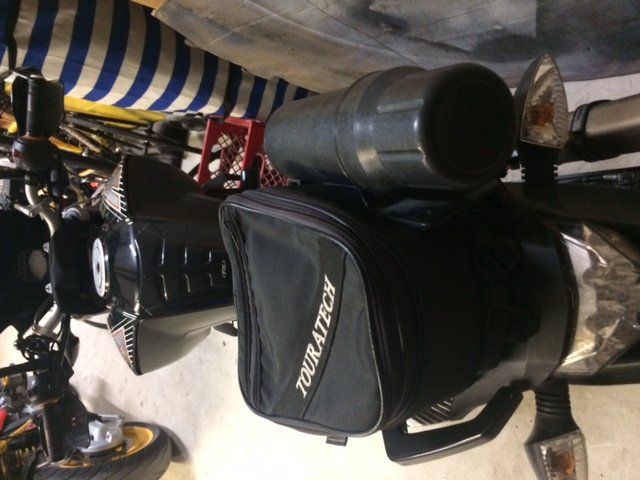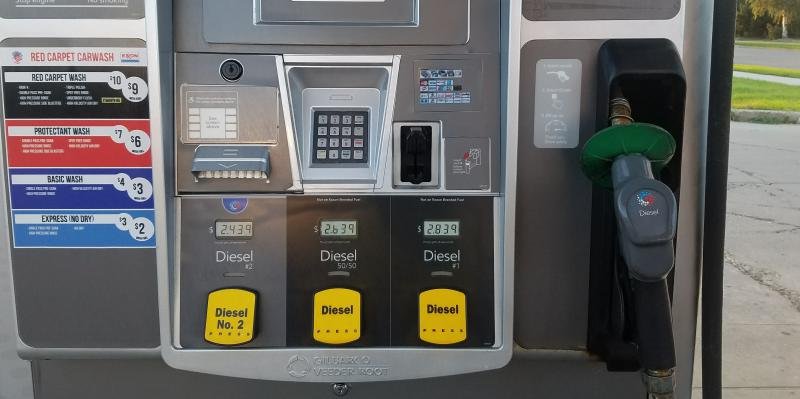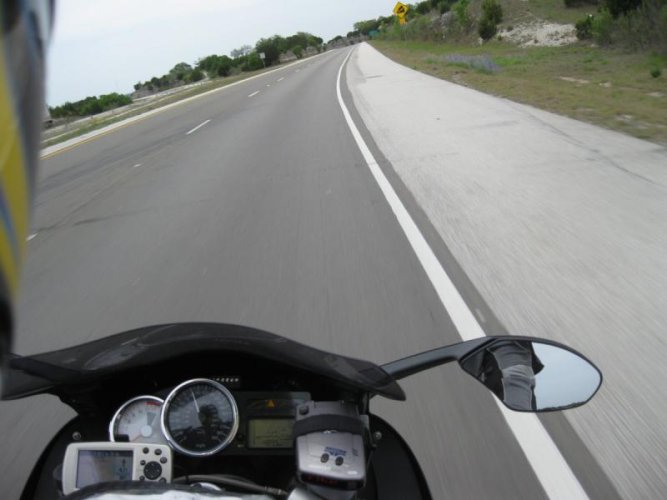Navigation
Install the app
How to install the app on iOS
Follow along with the video below to see how to install our site as a web app on your home screen.
Note: This feature may not be available in some browsers.
More options
-
Welcome, Guest! We hope you enjoy the excellent technical knowledge, event information and discussions that the BMW MOA forum provides. Some forum content will be hidden from you if you remain logged out. If you want to view all content, please click the 'Log in' button above and enter your BMW MOA username and password. If you are not an MOA member, why not take the time to join the club, so you can enjoy posting on the forum, the BMW Owners News magazine, and all of the discounts and benefits the BMW MOA offers?
You are using an out of date browser. It may not display this or other websites correctly.
You should upgrade or use an alternative browser.
You should upgrade or use an alternative browser.
Managing your fuel supply on long dry stretches
- Thread starter richardus
- Start date
jeffkruger
New member
There’s another factor to consider if riding in Oregon, especially eastern OR. Since Oregonians and their guests are not allowed to pump fuel into their own vehicles, it is quite possible to run into a town with multiple gas stations yet no gas availability at night when all the help goes off-duty. That leaves the rider with the option of gambling on the next town down the road or settling in to wait until next morning’s station opening. Been caught that way in Lakeview, OR once.
Oregon passed a law that allows stations in counties with under 40k population to install self-service pumps (effective today), but there are operators who are unwilling or fiscally unable to bear the cost of upgrading to CC-capable pumps for self service—even tho sundown-to-sunup self service has been an option for stations since 2015. So, it will still be possible to hit a rural OR station at night and be SOL for fuel.
Yet another kink in the fuel management line...
Best,
DG
Even before the new law took effect, the are commercial fueling stations in Oregon that are available 24/7 and you can pump you own fuel, if you get one of their cards.
Potential long distances between fuel stops is a big part of the reason I ride a GS Adventure. I don't have to fill the tank completely, but in situations where it's some distance between fuel stops, it's very handy. On a previous bike I had some of the Touratech mounts with their jugs that were sold as "oil jugs" but were fine for gas, mounted on the outside of my paniers.
Hey Henzilla, where on your Duke 390 did you attach the tool tube? I have stared at mine long and hard and there's not a lot of space for anything on those bikes.
Was a temporary trial for this trip with zip ties to grab rails. There isn't a good place I have found on frame. Sorry for the I-rotation of pics, will try and fix in a bit



wbrownell9
New member
One summer I helped not one but 2 people understand the petcocks and the concept of "reserve". They'd both bought their bikes recently and had zero orientation to the bike, let alone MSF course or some equivalent. One of them still had gas the other had been running on reserve - until he wasn't.
I personally have a GSA for the range as I have no offroad skills and at 64 I'm not interested in learning any (I break easily and heal slow). I was glad I could ride as usual even out west where gas stations are 100 miles apart or more. Although I nearly made a bad mistake when I pulled up to this 3-button pump in Bismark:

I personally have a GSA for the range as I have no offroad skills and at 64 I'm not interested in learning any (I break easily and heal slow). I was glad I could ride as usual even out west where gas stations are 100 miles apart or more. Although I nearly made a bad mistake when I pulled up to this 3-button pump in Bismark:

pglaves
#13338
Along the lines of that diesel pump, the Valero stations around here have green and yellow handles on some pumps.Have almost put gas in my diesel grabbing green nozzle until I got used to their setup.
BP stations used to have green handles on gasoline pumps too. Reading comprehension matters.
BP stations used to have green handles on gasoline pumps too. Reading comprehension matters.
fool me once...almost
I know for fact that a 700cc, three cylinder, two stroke SnoGo will run with with a tank with 50% diesel in it. Not real well, but well enough to get home.
A carburetored ford small block made it to my house with a panicy buddy after doing a 50/50. He said 30mph was about it and slower takeoffs. A tad smokey as well
Many decades ago when I asked my Volvo mechanic what was the most efficient speed, he replied 60mph for any gas powered motor. Once when riding about 40ish miles on fumes, that's what I set my speed at, in fifth gear. Made it to the gas station and the bike died as I rolled up to the pump, diesel, as it turned out. Only had to push the loaded K 20 feet to the proper pump.
My question is, was my mechanic correct? Is there a most efficient speed for optimum gas mileage. I do know that stop and go traffic wrecks havoc on decent gas consumption as does prolonged high speed.
My question is, was my mechanic correct? Is there a most efficient speed for optimum gas mileage. I do know that stop and go traffic wrecks havoc on decent gas consumption as does prolonged high speed.
pglaves
#13338
Many decades ago when I asked my Volvo mechanic what was the most efficient speed, he replied 60mph for any gas powered motor. Once when riding about 40ish miles on fumes, that's what I set my speed at, in fifth gear. Made it to the gas station and the bike died as I rolled up to the pump, diesel, as it turned out. Only had to push the loaded K 20 feet to the proper pump.
My question is, was my mechanic correct? Is there a most efficient speed for optimum gas mileage. I do know that stop and go traffic wrecks havoc on decent gas consumption as does prolonged high speed.
I have read that an engine is most efficient at the rpm that provides peak torque - obviously not peak horsepower. I stand ready to be corrected by qualified mechanical engineers specializing in internal combustion engines.
AKsuited
New member
I would think the answer has more to do with the work an engine is doing, rather than the characteristics of that engine: it must overcome rolling resistance and air resistance. Air resistance goes up exponentially rather than in a linear fashion. In other words, slower is better. Change in elevation of course is in there, too.
Rinty
New member
I know for fact that a 700cc, three cylinder, two stroke SnoGo will run with with a tank with 50% diesel in it. Not real well, but well enough to get home.
So your mix went from 50:1 to 1:1 in a couple of minutes.
Back in the last century, we had a national 55 mph speed limit. One of the things they used to sell it was the graph that showed how the gas consumption went up exponentially as speed increased over 55 to 60 and more....Is there a most efficient speed for optimum gas mileage. I do know that stop and go traffic wrecks havoc on decent gas consumption as does prolonged high speed.
I think you'd find a speed of around 40 mph would give you some of your best mpg.
managing fuel supply
The expectations of one who throws a turd in the punch bowl.....and then steps back to think of another topic ? This isn't the first bait the OP has chummed the waters with, not to be heard from again, one way or another, regarding that topic.
Friedle
I wonder if all this sage advice has met the OP's expectations?
The expectations of one who throws a turd in the punch bowl.....and then steps back to think of another topic ? This isn't the first bait the OP has chummed the waters with, not to be heard from again, one way or another, regarding that topic.
Friedle
KenDittrick
Rocky Bow BMW Riders #197
I would think the answer has more to do with the work an engine is doing, rather than the characteristics of that engine: it must overcome rolling resistance and air resistance. Air resistance goes up exponentially rather than in a linear fashion. In other words, slower is better. Change in elevation of course is in there, too.
Agree it is about the work done. The amount of Work done = force x distance and Power is a measure of how quickly work is being done. Power is work done / time taken. The units of work are Joules (J), where 1 J = 1 N∙m = 1 kg∙m2/s2. Now all of that does not provide the answer but it is the beginning of solving for answers taking in all the myriad of variables to the situation.
WOW! Oregon STILL has this law? Do any other states? Any reason for it still to exist? Brought back memories of touring in Oregon many years ago. The drill then was for the attendant to hand you the pump handle, then the rider filled the tank. (No liability for over-filling a tank and damaging paint, I presumed.) Yes, there used to be a problem of people filling their tank, then driving off without paying. Many years ago here in BC (and I maybe wrongly presumed everywhere) it became the law that you had to "pay before you pumped." Most people I assume insert their credit card, enter their password, pump their gas, get their receipt and leave. If you don't have a credit card, laying out cash for the attendant inside the store will also do the job, though it involves another foot trip to maybe get change.There’s another factor to consider if riding in Oregon, especially eastern OR. Since Oregonians and their guests are not allowed to pump fuel into their own vehicles, it is quite possible to run into a town with multiple gas stations yet no gas availability at night when all the help goes off-duty. That leaves the rider with the option of gambling on the next town down the road or settling in to wait until next morning’s station opening. Been caught that way in Lakeview, OR once.
Oregon passed a law that allows stations in counties with under 40k population to install self-service pumps (effective today), but there are operators who are unwilling or fiscally unable to bear the cost of upgrading to CC-capable pumps for self service—even tho sundown-to-sunup self service has been an option for stations since 2015. So, it will still be possible to hit a rural OR station at night and be SOL for fuel.
Yet another kink in the fuel management line...
Best,
DG
What is the advantage to a service station paying people to pump gas? That IS an option at one local station - and I use that one lane when my windows are filthy. But self-service gas is definitely the norm, except I guess in Oregon. Curious.
,
beemerphile
New member
Back in the last century, we had a national 55 mph speed limit. One of the things they used to sell it was the graph that showed how the gas consumption went up exponentially as speed increased over 55 to 60 and more.
I think you'd find a speed of around 40 mph would give you some of your best mpg.
That was my experience with a Honda NC700X. It usually got between 60-70 MPG driven at 55-60. I put it on the Natchez Trace Parkway and followed the park 45 MPH limit and got over 80 MPG. It was built for maximum economy at boring fall-asleep speeds. Surely gearing enters into that most efficient speed equation as well as cam profiles and other engine design parameters. I'd go with Paul's "RPM of max torque" suggestion as to where an engine is most efficient. I had an overly hopped up 57 Chevy in my youth that had such a radical cam that it was still passing fuel charge directly into the exhaust headers at 60 mph in top gear. It had no torque there either. Driving technique matters as well. I remember when cheap gauges to aid high mileage were just vacuum gauges with green-yellow-red bands as the vacuum reduced. You can go fast efficiently on downhills and trade off speed on the uphills and you will do better than holding a specific speed.
pglaves
#13338
What is the advantage to a service station paying people to pump gas? That IS an option at one local station - and I use that one lane when my windows are filthy. But self-service gas is definitely the norm, except I guess in Oregon. Curious.
Over the years folks in Oregon have cited two main reasons for the law. The legislature has argued that it is good for employment - jobs! Many locally owned stations/stores have argued that converting to self-serve pumps and equipment is too costly.
Is that all true? Maybe. Maybe not.
I have been in many small towns where the pumps are self-serve but not pay at the pump. Pull up. Fill tank. Go in. Pay.
Similar threads
- Replies
- 1
- Views
- 306


